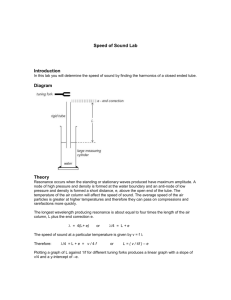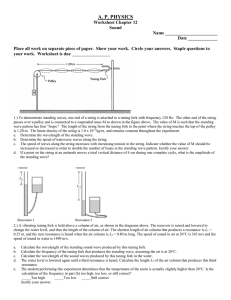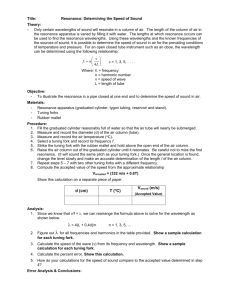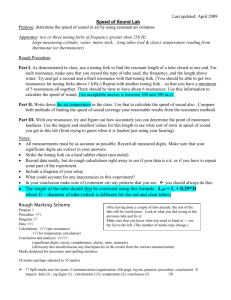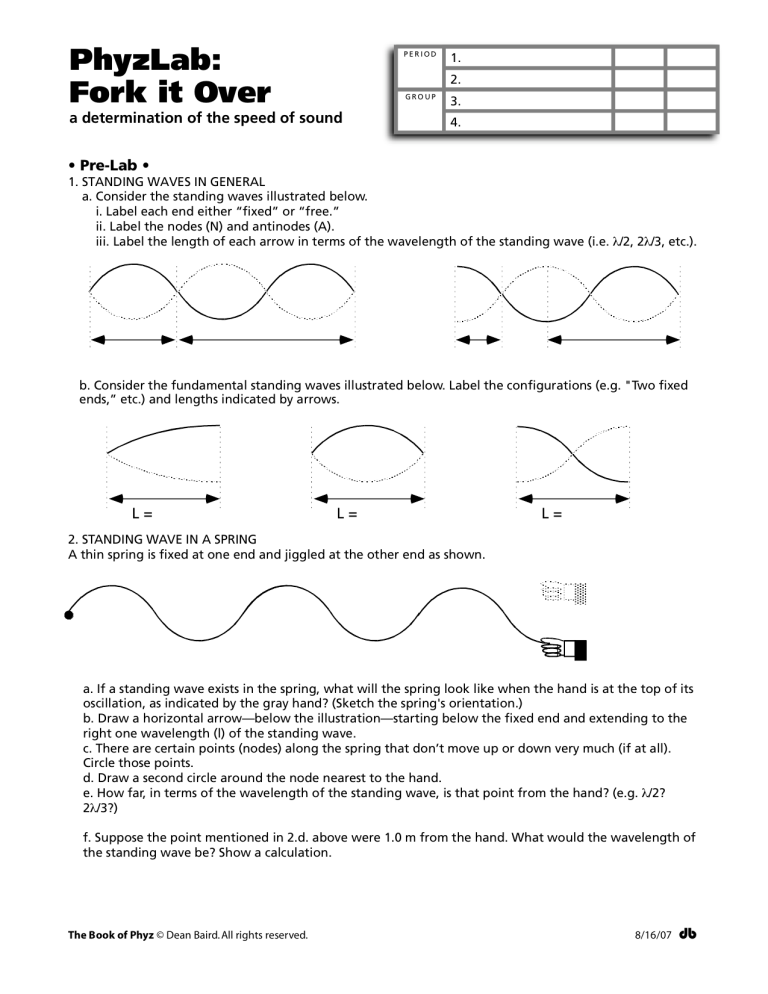
PhyzLab: Fork it Over PER IOD 1. 2. GROUP a determination of the speed of sound 3. 4. • Pre-Lab • 1. STANDING WAVES IN GENERAL a. Consider the standing waves illustrated below. i. Label each end either “fixed” or “free.” ii. Label the nodes (N) and antinodes (A). iii. Label the length of each arrow in terms of the wavelength of the standing wave (i.e. λ/2, 2λ/3, etc.). b. Consider the fundamental standing waves illustrated below. Label the configurations (e.g. "Two fixed ends,” etc.) and lengths indicated by arrows. L= L= L= 2. STANDING WAVE IN A SPRING A thin spring is fixed at one end and jiggled at the other end as shown. a. If a standing wave exists in the spring, what will the spring look like when the hand is at the top of its oscillation, as indicated by the gray hand? (Sketch the spring's orientation.) b. Draw a horizontal arrow—below the illustration—starting below the fixed end and extending to the right one wavelength (l) of the standing wave. c. There are certain points (nodes) along the spring that don’t move up or down very much (if at all). Circle those points. d. Draw a second circle around the node nearest to the hand. e. How far, in terms of the wavelength of the standing wave, is that point from the hand? (e.g. λ/2? 2λ/3?) f. Suppose the point mentioned in 2.d. above were 1.0 m from the hand. What would the wavelength of the standing wave be? Show a calculation. The Book of Phyz © Dean Baird. All rights reserved. 8/16/07 db g. If the wavelength of the standing wave were 4.0 m and the frequency of the jiggling hand were 5.0 Hz, what would the speed of waves in the spring be? (Show an equation before showing the calculation.) 3. A RESONATING COLUMN OF AIR Consider the arrangement shown below. One end of a column of air is fixed. A tuning fork oscillates the column at the open end. Within the tube, dark areas show high concentrations of air particles; light areas show low concentrations. air tube left tine tuning fork v x The graph above indicates the velocity of the air particles at all points within the tube at a given moment. That moment is when the left tine of the tuning fork is moving to the right, pulling the air at the open end to the right (the positive direction). a. Sketch (on the same axes above) what the velocity pattern will look like when the left tine is moving to the left, pushing the air at the open end to the left (negative direction). b. Draw a horizontal arrow—between the illustration and the graph—starting below the fixed end and extending to the right one full wavelength (λ) of the standing wave. c. There are certain points (nodes) along the air column at which no air particle motion occurs. Those are the points at which v = 0 on the air velocity vs. distance graph. Circle those points. d. Draw a second circle around the node nearest to the tuning fork. e. How far, in terms of the wavelength of the standing wave, is that point from the fork? f. Suppose the fixed end of the tube were at the node mentioned in 3.d. If that point were 22 cm from the fork, what would the wavelength of the standing wave be? Show the calculation. g. If the frequency of the tuning fork were 400 Hz, what would the wave speed (speed of sound) be? Show a calculation. (You know the frequency and the wavelength; calculate the wave speed.) The Book of Phyz © Dean Baird. All rights reserved. 8/16/07 db 4. WHAT CAN BE DONE WITH A RESONATING COLUMN OF AIR The purpose of the lab that follows is to determine the speed of sound in the air in this room. To do this, we will make sound waves with a known frequency and measure their wavelength. The product of frequency and wavelength is the wave speed. To do this, we will use tuning forks. The frequency at which a tuning fork vibrates is usually printed on the tuning fork itself. Knowing the wavelength of the sound wave made by the tuning fork is trickier. But we know some tricks. For example, we know that when a column of air resonates in a vessel or cavity as shown, it does so with one fixed end and one free end—a node and an antinode. And we know that the fundamental mode of vibration for which this resonance occurs corresponds to one quarter of the wavelength of the full standing wave. resonance tube resonant length A given tuning fork vibrates at a single frequency. To find the wavelength of the sound wave it generates, we will have the tuning fork drive a column of air into resonant vibration. But wait! The column of air will only resonate if its length is exactly one quarter the wavelength of the full sound wave. Even if we had a big supply of vessels with a variety of lengths, finding the right one would take a long time using “guess and check.” And it wouldn’t be much fun. But as mentioned above, we have tricks. Consider our tube within a tube apparatus shown below. Air in the inner tube can be driven to resonance by a tuning fork if the air column is just the right length. The length of the air column is the distance between the open end and the “closed end.” The outer tube is filled with water and the inner tube is partially immersed in that water. So the closed end of the air column is where the inner tube meets the water. But where’s the fun? The fun is in the fact that the inner tube can be raised or lowered until its size is just right for resonance: one quarter the wavelength of the standing wave generated by the tuning fork. When the resonant length is found, it must be measured and recorded. The wavelength of the standing wave is determined by multiplying the resonant length by four. The speed of sound can then be determined by multiplying the wavelength of the standing wave by the frequency of the tuning fork that’s driving it. water vessel base For example, a student finds that a 400 Hz tuning fork resonates the air in the inner tube when the inner tube’s open end is 22.0 cm above the water level. L So f = 400 Hz and L = 22.0 cm = 0.220 m. Since λ = 4L, λ = 4 · 0.220 m = 0.880 m. Since v = fλ, v = 400 Hz · 0.880 m = 352 m/s. And so we determined the speed of sound using a tuning fork with a known frequency to drive a standing wave in a vessel whose length we measured. Your turn. Work this one out. A 924 Hz tuning fork produces a wave whose resonance length in the tube is 9.1 cm. What is the wavelength of the wave and the speed of sound by this means? too short The Book of Phyz © Dean Baird. All rights reserved. just right too long 8/16/07 db • Purpose • In this activity, you will use the characteristics of a resonating column of air to determine the speed of sound in the air in this room. • Apparatus • ___ tuning fork or equivalent (with known frequency) ___ tuning fork mallet or strike object (cork ball or equivalent) ___ resonance tube (~50cm) (Aluminum, PVC, or equivalent) resonance tube Measure inner diameter: d = ________ ___ water vessel base (graduated cylinder, acrylic tubing, or equivalent) ___ support rod and base (optional) ___ buret clamp or three finger clamp (optional) ___ thermometer (or access to current room temperature) tuning fork water vessel base Record room temperature before you begin the lab: T = ________ NEVER STRIKE THE TUNING FORK WITH OR AGAINST ANY HARD OBJECT (SINCE DOING SO CAN CAUSE PERMANENT DAMAGE). STRIKE IT WITH A SPECIAL SOFT MALLET OR TAP IT AGAINST THE SOFT BOTTOM OF YOUR SHOE OR YOUR PATELLA. SILENCE! THIS ACTIVITY REQUIRES THAT EVERYONE BE QUIET. OTHERWISE, YOU WILL NOT BE ABLE TO HEAR WHAT YOU NEED TO HEAR. KEEP ALL VERBAL COMMUNICATION TO A MINIMUM: WHISPER WHEN YOU NEED TO SPEAK. • Procedure • 1. Fill the water vessel base and keep it vertical (by holding or using a rod and clamp). 2. Insert the resonance tube so that it is immersed as fully as possible. 3. Record the frequency of the tuning fork in the DATA section of the lab. 4. Strike the tuning fork. Hold it horizontally directly above the resonance tube. Raise both the fork and tube upward (one person should hold both the fork and the tube) while listening closely to the sound of the tuning fork in the tube. Find the shortest height at which the sound in the tube is unusually loud. At this point, the column of air in the tube is vibrating resonantly in a standing wave. This is the shortest standing wave that can “fit” in the resonance tube, and is therefore l/4 in length. 5. Measure the length of the resonant air column. On the diagram to the right, indicate the length L you measured. 6. Record this value in the DATA section of the lab. Get a second (independent) measurement of the length L of the resonant air column from another member of the lab group. Average the two values and record in the DATA section. 7. Repeat the procedure with as many other tuning forks as time and equipment allow. The Book of Phyz © Dean Baird. All rights reserved. too short just right too long 8/16/07 db • Data • f (Hz) L (m) λ (m) v (m/s) λ∗ (m) v∗ (m/s) 1 2 Avg 1 2 Avg 1 2 Avg 1 2 Avg • Analysis • 1. What is the resonance wavelength of the first tuning fork? Show work and describe the reasoning behind your calculation. Enter your result in the DATA section above. 2. What is the resonance wavelength of the second tuning fork? Show work. Enter your result in the DATA section above. 3. Determine the resonant wavelengths of the remaining tuning forks. Enter your results in the DATA section above. 4. What is the speed of sound in air, based on what you know about the first tuning fork? Show work and describe the reasoning behind your calculation. Enter your result in the DATA section above. 5. Determine the speed of sound in air, based on what you know about the remaining tuning forks. Enter your results in the DATA section above. 6. What is the average speed of sound as measured in the lab? 7. What is the actual speed of sound in the room? Use the following information. The speed of sound in air at 0 °C is 331.4 m/s, and increases by 0.6 m/s for every 1 °C rise in temperature. The Book of Phyz © Dean Baird. All rights reserved. 8/16/07 db 8. What is the percent error (not percent difference) in your measured value of the speed of sound? List sources of error (not mistakes) present in the lab. 9. To find the speed of sound in the lab, you used the relation v = fλ. Since λ was 4L, your effective equation was v = 4fL. It has been found that one source of error in this procedure is related to the diameter of the resonance tube. The wider the tube, the less accurate the wavelength determination is. The most accurate tube would have no diameter at all (although it wouldn’t be much of a tube). A correction factor has been developed to account for this small but measurable error. The wavelength is not simply λ = 4L, but rather λ* = 4(L + 0.4d), where d is the inner diameter of the resonance tube. Using this correction factor, recalculate the speed of sound from the data on each tuning fork. Use the “extra” column on the data table to record the corrected speeds. a. Resonance tube inner diameter (see APPARATUS section above): d = ____________________ b. Accepted (temperature-based) speed of sound: vact = __________________ c. Average speed of sound (uncorrected tuning fork-based): v = ____________________ d. Average speed of sound (corrected tuning fork-based): v* = ___________________ e. Does the correction lead to a better value of the speed of sound? Justify your answer in terms of percent error. The Book of Phyz © Dean Baird. All rights reserved. 8/16/07 db
